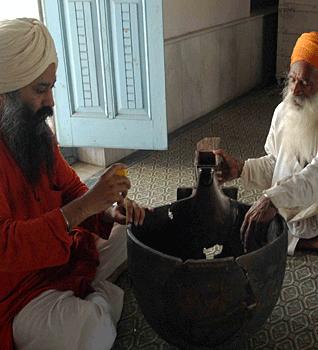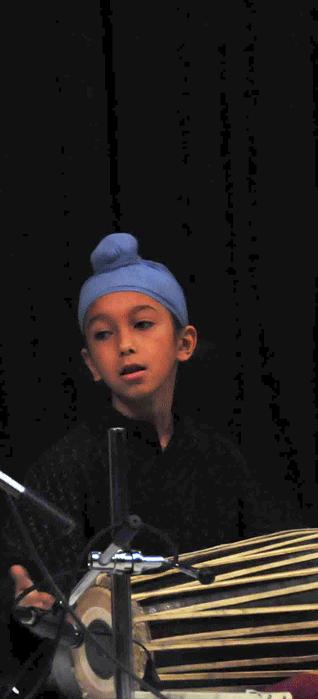Music
Bhai Baldeep Singh:
Preserving A Legacy
by CHARANDEEP SINGH
It is a journey that transcends boundaries.
It is a journey which made intangible heritage as tangible heritage.
It is a journey which gave succour to the quest of a desperate soul.
It is a journey in which passion became life.
It is a journey in which a child wanting to become a fighter-pilot ultimately becomes a music conservator (a conservator of music and arts).
Is the journey sounding too enigmatic? Well, these are revolving moments from the life of Bhai Baldeep Singh, who has undertaken the painstaking task of preservation and documentation of the sacred musical traditions and practices of the Sikhs.
Bhai Baldeep Singh, who is both a vocalist as well as percussionist, is the 13th generation exponent of the Sikh kirtan maryada. He says: "My spectrum of work includes the way Sikh Gurus recited the gurbani in various raag forms and the manner in which they made use of pristine musical instruments."
Bhai Baldeep Singh has undertaken a herculean project to revive almost all the instruments from the time of the Gurus by personally handcrafting them under the guidance of master luthier Gyani Harbhajan Singh of Hoshiarpur, a World War II veteran, who crafted these instruments until 1949.
Today, Bhai Baldeep Singh has the unique distinction of having carved the nomadic rebab (also known as the dhrupadi-rebab), the saranda, the taus, the dilruba, the tamburni (tanpura) and the pakhawaj (mridang) of Punjab.
He has also made a detailed audio-visual presentation on the subject, The Musical Instruments of Gurbani and Bhakti Traditions. With his efforts, Bhai Baldeep Singh has inspired people around the world to take up the musical instruments of the Gurus' court, and because of his endeavour, many institutions have included playing these instruments as a part of their curriculum.
Another documentary of his, The Sacred Music of the Sikhs, has received rave views and is shown at documentary film festivals all over the world.
Today, gurbani is recited with the tabla and the harmonium.
"Harmonium was invented in France and became the mainstay instrument of beggars in Europe. Since it is compact in shape, it is easy to carry. Harmonium was never used in western classical music. However, it has become the mainstay of Indian classical music. These kinds of practices have destroyed the subtle nuances of the Gurbani Kirtan, which need to be restored," says Bhai Baldeep Singh.
To quench his thirst for assimilating the pure form of gurbani kirtan and the instruments used, he travelled far and wide, and as a result, he took tutelage from more than 27 elders of different genres of music, all of whom he considers as the bank of the music of the Gurus.
"Merely singing in raags is not the way the Gurus preached. The key is to know that the gurbani was written from the 11th century onwards at the time of Baba Sheikh Farid to 1708 AD, till the time Guru Gobind Singh left the world. So, in these six centuries, music must have also evolved. For example, raag Jaijaivanti was only used by Guru Tegh Bahadar. Guru Nanak never recited shabads in this raag. On the other hand, Guru Nanak made ample use of 19 raags out of the 31 that appear in the entire Gurbani. I consider it my responsibility to learn how the Gurus recited their bani in the music form," reveals Bhai Baldeep Singh, who received the Delhi State Annual Award in 2003 for his contribution to the field of music.
During his travels, he even used to meet rebabis who had something to share about the heritage of the great Gurus. His research has indeed unveiled a treasure and given society a lot of information about the various forms of music prevalent during the times of the Gurus. His focus is very clear ... he wants to conserve music.
Bhai Baldeep Singh is the founder and managing trustee of the Anad Foundation, a non-profit organisation dedicated to the promotion and preservation of traditional culture.
"At the Anad Foundation, we have probably one of the finest audio recording studios in the entire South Asia, where we have more than 600 hours of live recordings. We have digitalized, restored and edited many private collections from 1950-52 onwards. Many of these original records are fascinating and precious memories of some of the finest exponents of Indian classical music. I want to preserve this rich legacy and want to present it to the generations to come so that they are not bereft of intricate nuances of pure vintage music," speaks Bhai Baldeep Singh in a philosophical tone.
He is in the process of developing an Anad conservatory, an institute of arts, aesthetics, cultural traditions and developmental studies, a Rs 500-crore project, at Sultanpur Lodhi, Kapurthala (Punjab).
Taking his legacy forward are his two sons.
"My elder son, Luigi Hari Tehal Singh(14), made his debut with the rebab on stage with me last year. My younger one, Leonardo Amar Dhyan Singh(12), associated with the pakhawaj, made his debut in April 2008 and received some rave reviews," says the proud father.
[Courtesy: Tribune]
March 21, 2011




